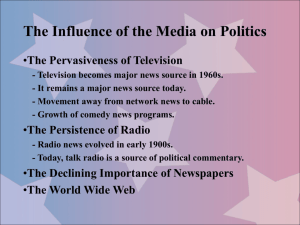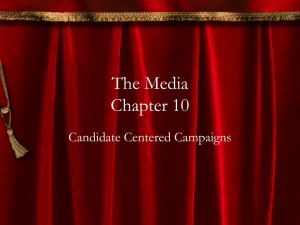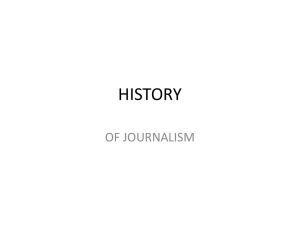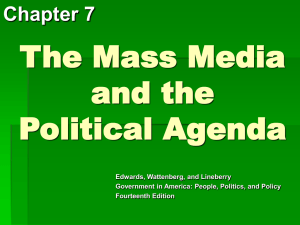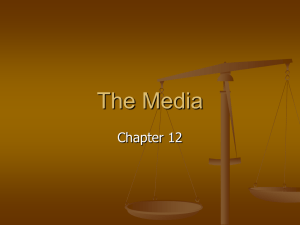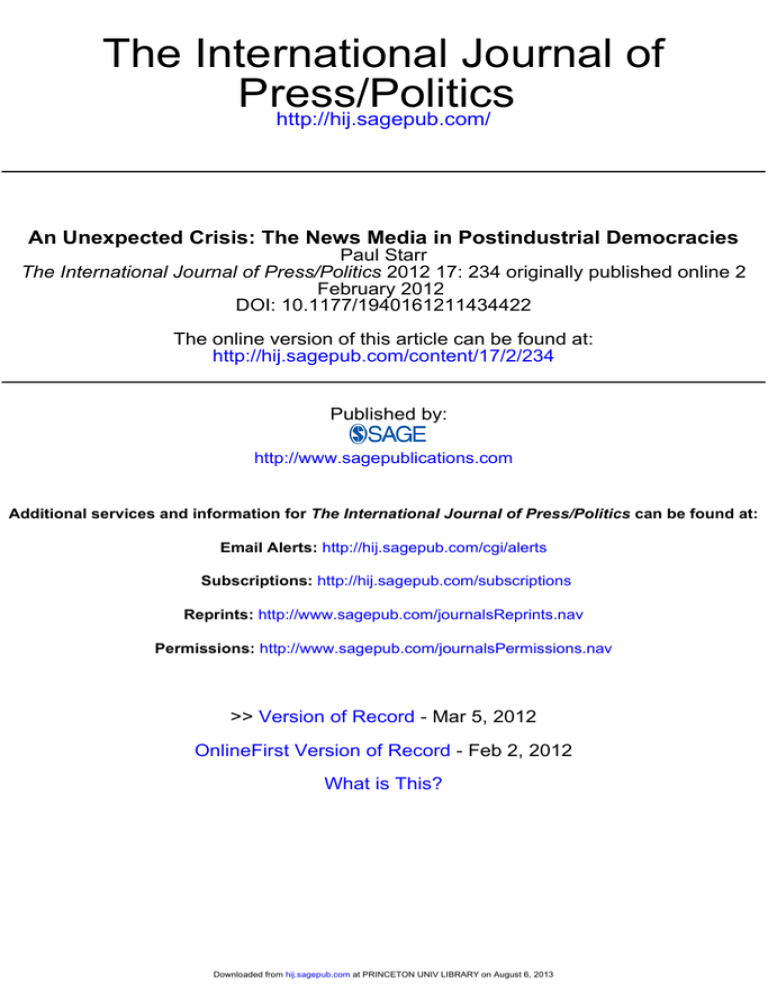
The International Journal of
Press/Politics
http://hij.sagepub.com/
An Unexpected Crisis: The News Media in Postindustrial Democracies
Paul Starr
The International Journal of Press/Politics 2012 17: 234 originally published online 2
February 2012
DOI: 10.1177/1940161211434422
The online version of this article can be found at:
http://hij.sagepub.com/content/17/2/234
Published by:
http://www.sagepublications.com
Additional services and information for The International Journal of Press/Politics can be found at:
Email Alerts: http://hij.sagepub.com/cgi/alerts
Subscriptions: http://hij.sagepub.com/subscriptions
Reprints: http://www.sagepub.com/journalsReprints.nav
Permissions: http://www.sagepub.com/journalsPermissions.nav
>> Version of Record - Mar 5, 2012
OnlineFirst Version of Record - Feb 2, 2012
What is This?
Downloaded from hij.sagepub.com at PRINCETON UNIV LIBRARY on August 6, 2013
434422
arrThe International Journal of Press/Politics
HIJ17210.1177/1940161211434422St
Invited Article
An Unexpected Crisis:
The News Media in
Postindustrial Democracies
The International Journal of Press/Politics
17(2) 234­–242
© The Author(s) 2012
Reprints and permission:
sagepub.com/journalsPermissions.nav
DOI: 10.1177/1940161211434422
http://ijpp.sagepub.com
Paul Starr1
Abstract
Social and political theory in the twentieth century envisioned the flourishing of both
democracy and the information economy. But while the digital revolution has promoted
freedom of expression and freedom of information, it has had mixed effects on the
freedom of the press. Throughout the advanced democratic world –more acutely in
some countries than in others –the rise of digital communications has undermined
the financial condition and economic independence of the press. New media have
not, as of yet, offset losses in more traditional media. With its high dependence on
advertising revenue, American journalism has been especially vulnerable to stress. In
the late twentieth century, observers expected the news media in Europe to evolve
in an American direction; instead American journalism has been moving in a more
European direction –more partisan and less financially secure –though public policy in
the United States shows no signs of adjusting to the new realities.
Keywords
freedom of the press, digital media, media economics, comparative media systems
The digital revolution has unquestionably been good for freedom of expression—
for the free expression, that is, of opinion. It has also been good for freedom of
information—for making previously inaccessible information more widely available.
But it has not been so good for freedom of the press, if one understands that freedom
as referring not merely to the formal legal rights but to the real independence of the
press as an institution.
The digital revolution has been good for freedom of expression because it has
increased the diversity of voices in the public sphere. The digital revolution has been
1
Princeton University, NJ, USA
Corresponding Author:
Paul Starr, Professor of sociology and public affairs, Princeton University. Sociology Department, Wallace
Hall, Princeton University, Princeton NJ
Email: starr@Princeton.EDU
Downloaded from hij.sagepub.com at PRINCETON UNIV LIBRARY on August 6, 2013
235
Starr
good for freedom of information because it has made government documents and data
directly accessible to more people and has fostered a culture that demands transparency from powerful institutions. But the digital revolution has both revitalized and
weakened freedom of the press. It has revitalized journalism by allowing new entrants
into the media and generated promising innovations, and in countries where the press
has been stifled, that effect is the most important. But in the established democracies,
the digital revolution has weakened the ability of the press to act as an effective agent
of public accountability by undermining the economic basis of professional reporting
and fragmenting the public. If we take seriously the idea that an independent press
serves an essential democratic function, its institutional distress may weaken
democracy itself.
And that is the danger that confronts us: Throughout the postindustrial world, the
news media face a serious long-term crisis that social theory did not anticipate.
Beginning in the 1970s, theories of postindustrial society projected a flourishing
and happy future for the fields associated with the production of knowledge and information. As information became more valuable, more people would be employed producing it, and the professions responsible for that work would receive higher rewards
and gain authority and status on the basis of their knowledge.1 The most influential
theories of contemporary political development also did not anticipate a crisis in the
news media that would pose a problem for democracy. As the twentieth century came
to a close, the collapse of communism and the Soviet Union gave rise to increased
confidence—in some quarters, triumphalism—about the future of liberal democracy
and its institutions.2 The Internet and other new media initially seemed to reinforce
that confidence. As the digital revolution developed, its theorists argued that it inevitably
creates a more open, networked public sphere, thereby strengthening democratic values and practices.3 In short, all of these perspectives have suggested that in the postindustrial world, a free press and democracy would thrive together.
Social theorists were not alone in their optimism. The professionals and executives
in the news media—at least in the United States—shared that same confidence about
the prospects for growth in their industry.4 Through the last decades of the twentieth
century, the trends throughout the economically advanced societies supported these
expectations. Like the other knowledge-producing professions, journalism expanded.
In the United States, from 1978 to 1990, the number of journalists at news organizations increased by 40 percent, up from 40,000 to 56,900.5 Moreover, the values of
freedom of expression, freedom of information, and freedom of the press became
more widely respected in the world as the number of democracies in Europe, the
Americas, and elsewhere rose. With the advent of personal computers and the Internet,
the costs of producing and distributing media of all kinds diminished, and previously
marginalized groups and individuals could bypass the old mass-media gatekeepers in
reaching a wider public.
But in recent years, the contemporary transformation has taken a darker turn for
journalism and for democratic government more generally. Several long-term trends
have combined to weaken the finances of the news media and to reduce professional
Downloaded from hij.sagepub.com at PRINCETON UNIV LIBRARY on August 6, 2013
236
The International Journal of Press/Politics 17(2)
employment in journalism. A recent OECD study reports that over the decade ending in
2007, the number of newspaper employees declined 53 percent in Norway, 41 percent
in the Netherlands, 25 percent in Germany, and 11 percent in Sweden, while holding
steady in France and Britain.6 In the United States, the number of journalists has fallen
back down from 56,900 to 41,500, according to a recent census of newsrooms.7
Everywhere, the media are under severe financial stress. The data on revenue for
newspapers, magazines, and other news media in the rich democracies typically show
a pattern of growth through the last three decades of the twentieth century, a peak
around the year 2000, and then a decline in the past decade, accelerating in the last
several years.
The expectation that the news media would flourish in postindustrial society failed
to take into account certain economic realities, social trends already in progress, and
emerging technologies. The prevailing optimism ignored the reality that information,
including news, is a public good and that public goods tend to be systematically underproduced in the market.
The prevailing optimism failed to consider that the news media had been able to
overcome the public-goods problem, with varying degrees of success, only because
existing communications technologies had limited the ways for the public to find
information and entertainment and for advertisers to reach consumers. And even
though it should have been clear that new technologies would expand the choices for
both advertisers and the public, hardly anyone anticipated that in this new environment, the public would fragment, the audience for news would shrink, advertisers
would be able to reach their markets without sponsoring news, and the traditional
commercial basis for financing journalism would be shattered.
These developments are not playing out exactly the same way everywhere. Because
of historical differences in institutions and varying rates of change in media use, the
crisis in the news media is more severe in some countries than others. The contemporary developments are also changing the structure of media institutions, upsetting
long-held patterns. After a period when the media in Europe were moving closer to an
American model, the reverse is now taking place, and in some crucial respects, the
American news media are coming to look more like the European. But for both ideological and institutional reasons, the United States may find it more difficult to respond
to these new conditions than do countries with strong traditions of public-service
broadcasting and government aid to the press.
Structural change in the news media
Since World War II—and in certain respects, going back even to the nineteenth century—
three distinct institutional patterns have emerged in the news media in the United States
and northern and southern Europe. Forgive me if in sketching these differences, I borrow
from Daniel Hallin and Paolo Mancini and use a broad brush, ignoring exceptions and
nuances.8 The big picture captures elements that are important for understanding the
contemporary crisis.
Downloaded from hij.sagepub.com at PRINCETON UNIV LIBRARY on August 6, 2013
237
Starr
As a general rule, while the press in Europe has been more closely tied to politics,
the press in the United States has been more commercial in its orientation. European
newspapers typically follow party lines, while American newspapers present themselves as being independent. In addition, the news media have been more centralized
at the national level in Europe but more widely distributed in the United States. These
patterns were originally established in newspapers and carried over, in varying degrees,
to radio and television.
Within Europe, newspaper circulation per capita has generally been lower in southern
than in northern European countries. This is a legacy of earlier historical differences. In
the late nineteenth and early twentieth centuries, while a mass press emerged in northern
Europe, it failed to develop in the Mediterranean countries because of a continuing lag in
literacy rates and particularly in newspaper reading among women. And if a mass press
did not emerge by the time radio and television arrived, broadcasting then assumed a
more central role in communication, and newspaper circulation continued to lag.
Differences in newspaper circulation typically affect the relationship of the press to
political parties and the state. Where circulation is low, the press tends to be more
closely connected to politics, and the style of writing tends to be more polemical.
Where circulation is higher, the press generally derives more of its revenue from
advertising, depends less on political sponsorship, often downplays strident partisanship, and spurns literary ideals in favor of a plainer, more popular style. In addition,
during the early development of radio and television, southern European countries
tended to keep broadcasting under direct political control, whereas northern European
countries—including Britain—vested greater authority in professionalized, publicservice broadcasting systems.
As a result of these differences in historical development, the news media in southern
Europe developed in a pattern that Hallin and Mancini call “polarized pluralism,” as
against the more highly professionalized, albeit still politically oriented, news media
of northern Europe, and the thoroughly commercial and ostensibly nonpartisan and
independent journalism of the United States.
During the final decades of the twentieth century, media systems in Europe appeared
to be moving toward the American commercial model, particularly as a result of the
privatization and liberalization of television. More private channels, less regulation of
their program content, and more dependence on advertising all suggested a long-term
movement in the direction of American commercialism. Some sociologists overtheorized the change, seeing in it an inherent tendency of modern societies toward the
differentiation of journalism from politics.9 But the shift reflected political choices,
not an ineluctable modernization process.
While the media in Europe moved toward a more liberalized, market orientation,
the news media in the United States during the late twentieth century were becoming
even more market-oriented than they had been. Long been owned by families who
were highly protective of their editorial quality, many newspapers were sold to chains
and conglomerates that demanded they generate higher financial returns. Similarly,
television networks that had originally operated news divisions at a loss began to
Downloaded from hij.sagepub.com at PRINCETON UNIV LIBRARY on August 6, 2013
238
The International Journal of Press/Politics 17(2)
expect those divisions to generate a profit on their own. These changes in media businesses reflected a more general shift in the norms of American corporate management.
Increasingly, management came to see the maximization of shareholder value as the
corporation’s sole, guiding principle. At media companies, executives sought to
increase financial returns by cutting back editorial staff even before the Internet and
other changes eroded revenues.
In all the postindustrial societies, the increased number of television channels and
the advent of the Internet, mobile phones, and social networks have expanded media
options for consumers and fragmented the attention of the public. In the early decades
of television, when the viewing public in both Europe and the United States had few
alternatives, the news often had a captive audience. As television channels proliferated, however, viewers who preferred entertainment could avoid watching the news,
while those with strong interests in politics could watch more news than before. With
the spread of cable television in the United States, according to my colleague Markus
Prior’s study Post-Broadcast Democracy, about 10 percent of the old TV news audience chose to watch more news, while about 30 percent stopped watching any news at
all.10 The traditional network-news audience included many viewers with low political
interest, but cable news tends to draw the most politically interested and most partisan.
Adapting to that reality, the cable news channels with the highest ratings have become
sharply partisan.
The Internet is moving news and public discussion in the same direction. More
choice allows partisans to seek out news that fits their political preferences, and as a
result, partisan media are thriving on the Internet as they are on cable television.
Furthermore, as regional newspapers have abandoned bureaus in Washington and
overseas, both national and international news coverage have become concentrated in
a few national news organizations. Among those organizations, New York Times represents a more liberal perspective, the Wall Street Journal a conservative one. In short,
the American media system is moving in a European direction—toward a more ideological organization of both the public and the news media, and a more consolidated
national press.
In the new environment, while the politically interested increasingly learn about the
world through partisan media, people without strong political interests are less likely
to encounter the news at all. In the past, when they bought a newspaper or watched
television, many people who were not especially interested in politics were nonetheless exposed to news about public affairs. The old media environment encouraged
incidental political learning. In the new media environment, however, people watch
entertainment, check in with friends on Facebook, or find out about sports, the weather,
or job listings on the Internet without being exposed to news about the wider world. As
a result, many people have effectively dropped out of the public, while the remainder
sees politics increasingly through the lens of polarized news media. That, at least,
seems to be the new structure of the public in the United States.
Although partisan media are hardly a novelty in Europe, the public may be shrinking here too, if the media use of the young is any indication. During the 1950s and 60s,
Downloaded from hij.sagepub.com at PRINCETON UNIV LIBRARY on August 6, 2013
239
Starr
surveys in both Europe and the United States recorded relatively small differences
between young adults and older age groups in patterns of reading newspapers or
watching TV news. That was still the predominant pattern in the early 1980s, when the
World Values Survey asked people whether they regularly read a newspaper. In ten of
thirteen countries, young adults were only slightly less likely than older age groups to
read newspapers regularly. More recent surveys of newspaper reading, however, have
shown increasingly pronounced variations by age. Growing generational differences
have also appeared in surveys of television news audiences. Young adults are now
much less likely than their parents or grandparents to read newspapers or watch television news.11
The change is not, I think, just a matter of the young substituting new media for old
ones, at least in the United States. As media use has become more individualized, news
has ceased to be a shared experience in the home. In the first three to four decades after
World War II, reading the newspaper over breakfast and watching the television news
in the evening were regular events, almost rituals, in many families. But as those practices have waned, families have not socialized the young into regular news habits to
the same degree as in the mid-twentieth century.
Unfortunately, no systematic cross-national data are available on trends in exposure to
news that take all media, new and old, into account. Such data are available, however, for
the United States, though the trends are unclear. Between 1998 and 2008, according to
surveys by the Pew Research Center, the proportion of Americans who said they didn’t
get the news in any medium on an average day rose from 14 percent to 19 percent. Among
18- to 24-year-olds during the same period, the proportion who said they get no news on
an average day rose from 25 percent to 34 percent.12 But the most recent survey shows an
increase in the average number of minutes a day people are spending on the news.
Whether that is a blip or the start of a recovery in news consumption is impossible to say.13
Variations in the News Crisis
The cross-national differences in media institutions may help explain the variations in
the severity of the crisis that the news media face.
The news media in the United States have been especially vulnerable for three separate reasons. First, American newspapers have derived 80 percent of their revenue from
advertising, and much of that advertising revenue has been irreversibly lost. Metropolitan
newspapers used to enjoy a stranglehold on certain categories of advertising. The
Internet has now broken that monopoly and provided advertisers with alternatives that
are often better and cheaper than what newspapers can offer.
Second, chiefly as a result of generational change, American newspapers have
experienced comparatively large, long-term losses in circulation that have intensified
in recent years. So income from circulation as well as advertising is under pressure.
Third, through mergers, acquisitions, and leveraged buyouts, many newspaper
companies took on heavy debt burdens just before their advertising revenue began to
collapse. Unable to deliver expected profits, the newspaper industry lost nearly all of
its market value, and eight major newspaper companies went bankrupt.14
Downloaded from hij.sagepub.com at PRINCETON UNIV LIBRARY on August 6, 2013
240
The International Journal of Press/Politics 17(2)
While American newspapers made a steep descent from monopoly returns to financial collapse, newspapers in southern Europe were never so profitable in the first
place. As in the United States, their papers have been vulnerable to a crisis but for
different reasons—endemic weaknesses in both advertising and circulation, exacerbated by contemporary trends.15
In contrast, the most stable news media appear to be those of northern Europe, with
relatively strong newspaper circulation and public-service broadcasting systems that
are less vulnerable to commercial downturns because they were never as dependent on
advertising as the American news media.
Some Europeans, observing the bankruptcy of some leading American media companies, may be unable to avoid a certain schadenfreude. After all, Americans have not
exactly been modest about their achievements in the development of media. But
because of the underlying changes in technology and society, print media that have
been the heart of journalism are likely to lose paid circulation and advertising everywhere. I am not saying that news organizations are going to disappear, but their capacities
are likely to be weakened in three respects. First, economic pressures will likely undermine their capacity for original reporting of the news. Second, in the new fragmented
media environment, they will no longer be able to assemble on a daily basis the great,
mass public that they were able to create in the past. And, third, with fewer resources
and less influence over public opinion, they will be less capable of standing up to
powerful interests in both the state and private sector.
This deterioration in institutional capacity brings us back to the original problem
that a crisis in the news media poses for democracy. Several studies indicate that corruption flourishes where journalism does not. In cross-national studies, the greater the
free circulation of newspapers—a combined measure of freedom of the press and
newspaper circulation per capita—the lower is the level of political corruption.16 Other
studies suggest that where there is less news coverage, political incumbents enjoy a
greater electoral advantage over challengers.17 Those findings make sense together.
The less news coverage, the more entrenched political leaders become and the more
likely they are to be to abuse power.
That is the danger. But if we are aware of its full dimensions, we may be better able
to respond to it. Subsidizing the old print media is just a holding action; money would
be better spent to support new online forms of journalistic enterprise and to help the
news media seize opportunities for new streams of revenue from mobile phones and
other mobile devices. Governments should also create incentives or set requirements
in the design of media interfaces and the media environment that lead people to bump
into the news routinely, even if they don’t intend to search it out.
In this new phase of development, the United States may well suffer from selfimposed disadvantages. Most Americans, including those in the news industry, reject
out of hand any form of government assistance and say noncommercial support for
journalism must come entirely from private, philanthropic sources. But it is hard to see
how philanthropy can match the resources that are being lost. Since 2000, the newspaper industry alone has lost an estimated “$1.6 billion in annual reporting and editing
Downloaded from hij.sagepub.com at PRINCETON UNIV LIBRARY on August 6, 2013
241
Starr
capacity . . . or roughly 30%,” but the new nonprofit money coming into journalism
has made up less than one-tenth that amount.18 Countries with long-established publicservice broadcasters may be better equipped, ideologically and institutionally, to deal
with the challenges of the media crisis. The American media system, I’ve suggested,
has recently moved in a European direction, at least in some respects. What the United
States really needs to do in that direction is to invest substantial resources to transform
its limited public broadcasting networks into a strong, multi-platform system of independent public media. Nowhere will that be an easy transition, but a great deal hinges
on how well our societies carry it out.
Author’s Note
This article was previously published in John Lloyd and Janice Winter (eds.), Media, Politics
and the Public (Stockholm: Axel and Margaret Ax:son Johnson Foundation, 2011), pp. 21-29.
Published with permission of the Ax: son Johnson Foundation.
Declaration of Conflicting Interests
The author declared no potential conflicts of interest with respect to the research, authorship,
and/or publication of this article.
Funding
The author received no financial support for the research, authorship, and/or publication of this
article.
Notes
1. Daniel Bell, The Coming of Post-Industrial Society (New York: Basic Books, 1973).
2. Francis Fukuyama, The End of History and the Last Man (New York: Free Press, 1992).
3. For the most sophisticated version of this argument, see Yochai Benkler, The Wealth of
Networks: How Social Production Transforms Markets and Freedom (New Haven, CT:
Yale University Press, 2006).
4. A collection from the early 1990s typical of the time shows no inkling of what lay ahead: Philip
S. Cook et al., The Future of News (Washington, DC: Woodrow Wilson Center Press, 1992).
5. American Society of Newspaper Editors, “Decline in U.S. Newsrooms Slows” (April 11,
2010), http://asne.org/article_view/articleid/763/decline-in-newsroom-jobs-slows.aspx.
6. Organization for Economic Cooperation and Development, “The Evolution of News and
the Internet” (Paris, December 2009), 19.
7. American Society of Newspaper Editors, “Decline in U.S. Newsrooms Slows.”
8. Daniel C. Hallin and Paolo Mancini, Comparing Media Systems: Three Models of Media
and Politics (New York: Cambridge University Press, 2004).
9. Jeffrey C. Alexander, “The Mass News Media in Systemic, Historical and Comparative
Perspective,” in Elihu Katz and Tamás Szecskő, eds., Mass Media and Social Change
(Beverly Hills, CA: SAGE, 1981), 17-51.
10. Markus Prior, Post-Broadcast Democracy: How Media Choice Increases Inequality in Political Involvement and Polarizes Elections (New York: Cambridge University Press, 2007).
Downloaded from hij.sagepub.com at PRINCETON UNIV LIBRARY on August 6, 2013
242
The International Journal of Press/Politics 17(2)
11. For a review of the data, see Martin P. Wattenberg, Is Voting for Young People? (New York:
Pearson Longman, 2008), esp. 9-33.
12. Pew Research Center for the People and the Press, “Audience Segments in a Changing
News Environment,” News Consumption and Believability Study (August 17, 2008), 5,
http://people-press.org/reports/pdf/444.pdf.
13. Pew Research Center for the People and the Press, “Americans Spend More Time Following the News” (September 12, 2010), available at http://people-press.org/report/652/.
14. Paul Starr, “Goodbye to the Age of Newspapers (Hello to a New Era of Corruption,” The
New Republic, March 4, 2009, 28-35.
15. See, e.g., Alice Antheaume, “The French Press and Its Enduring Institutional Crisis,” in David
A.L. Levy and Rasmus Kleis Nielsen, The Changing Business of Journalism and its Implications for Democracy (Oxford: Reuters Institute for the Study of Journalism, 2010), 69-80.
16. Alicia Adserà, Carles Boix, and Mark Payne, “Are You Being Served? Political Accountability and the Quality of Government,” Journal of Law, Economics, and Organization
19 (2003), 445-489; Aymo Brunettia and Beatrice Weder, “A Free Press Is Bad News for
Corruption,” Journal of Public Economics 87 (2003), 1801-24.
17. Sam Schulhofer-Wohl and Miguel Garrido, “Do Newspapers Matter? Evidence from the
Closure of the Cincinnati Post,” NBER Working Paper No. 1487 (2009); James M. Snyder,
Jr., and David Stromberg, “Press Coverage and Political Accountability,” NBER Working
Paper No. 13878 (2008).
18. Project for Excellence in Journalism, “Overview,” in “State of the News Media 2010,”
available at http://www.stateofthemedia.org/2010/overview_intro.php.
Downloaded from hij.sagepub.com at PRINCETON UNIV LIBRARY on August 6, 2013

